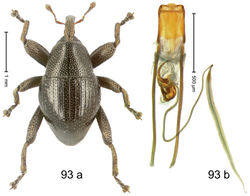Trigonopterus uniformis
| Notice: | This page is derived from the original publication listed below, whose author(s) should always be credited. Further contributors may edit and improve the content of this page and, consequently, need to be credited as well (see page history). Any assessment of factual correctness requires a careful review of the original article as well as of subsequent contributions.
If you are uncertain whether your planned contribution is correct or not, we suggest that you use the associated discussion page instead of editing the page directly. This page should be cited as follows (rationale):
Citation formats to copy and paste
BibTeX: @article{Riedel2013ZooKeys280, RIS/ Endnote: TY - JOUR Wikipedia/ Citizendium: <ref name="Riedel2013ZooKeys280">{{Citation See also the citation download page at the journal. |
Ordo: Coleoptera
Familia: Curculionidae
Genus: Trigonopterus
Name
Trigonopterus uniformis Riedel sp. n. – Wikispecies link – ZooBank link – Pensoft Profile
Diagnostic description
Holotype, male (Fig. 93a). Length 2.68 mm. Color black; legs deep ferruginous, antenna light ferruginous. Body ovate, with weak constriction between pronotum and elytron; in profile almost evenly convex. Rostrum dorsally in basal half rugose-punctate, in apical half punctate. Pronotum densely punctate except along partly impunctate midline. Elytra densely punctate with small punctures; striae impressed as fine lines; intervals with confused punctures; lateral stria behind humeri with row of deep punctures. Femora in apical 1/3 with anteroventral ridge terminating as tooth. Metafemur with denticulate dorsoposterior edge; subapically with stridulatory patch. Metatibia apically with uncus, premucro, and supra-uncal tooth. Aedeagus (Fig. 93b) medially weakly extended; transfer-apparatus asymmetrical, spiniform, curved; endophallus basally with shell-shaped sclerite; ductus ejaculatorius with bulbus. Intraspecific variation. Length 2.50–2.78 mm. Female rostrum dorsally subglabrous, sparsely punctate, basally sparsely squamose.
Material examined
Holotype (MZB): ARC0769 (EMBL # HE615452), WEST NEW GUINEA, Manokwari, Mt. Meja, S00°51.497', E134°04.949', 220 m, 05-XII-2007. Paratypes (ARC, SMNK, ZSM): WEST NEW GUINEA, Manokwari, Mt. Meja: 2 exx, ARC0220 (EMBL # HE615157), ARC0221 (EMBL # HE615158), 200 m, 31-I-2006; 1 exx, S00°51.400', E134°04.918', 225 m, 06-XII-2007; 2 exx, ARC0770 (EMBL # HE615453), ARC0771 (EMBL # HE615454), same data as holotype; 4 exx, 200 m, 30-XII-2000 – 01-I-2001; 3 exx, 22-23-IX-1990; 7 exx, 200 m, 24-VIII-1991; 1 ex, 200 m, 18-III-1993.
Distribution
Manokwari Reg. (Mt. Meja). Elevation: 200–225 m.
Biology
Beaten from foliage of lowland forest.
Etymology
This epithet is based on the Latin adjective uniformis (uniform) and refers its average habitus which is similar to hundreds of other Trigonopterus species.
Notes
Trigonopterus uniformis Riedel, sp. n. was coded as “Trigonopterus sp. 118” by Tänzler et al. (2012)[1].
Original Description
- Riedel, A; Sagata, K; Surbakti, S; Rene Tänzler, ; Michael Balke, ; 2013: One hundred and one new species of Trigonopterus weevils from New Guinea ZooKeys, 280: 1-150. doi
Other References
- ↑ Tänzler R, Sagata K, Surbakti S, Balke M, Riedel A (2012) DNA barcoding for community ecology - how to tackle a hyperdiverse, mostly undescribed Melanesian fauna. PLoS ONE 7 (1): e28832. doi: 10.1371/journal.pone.0028832
Images
|
